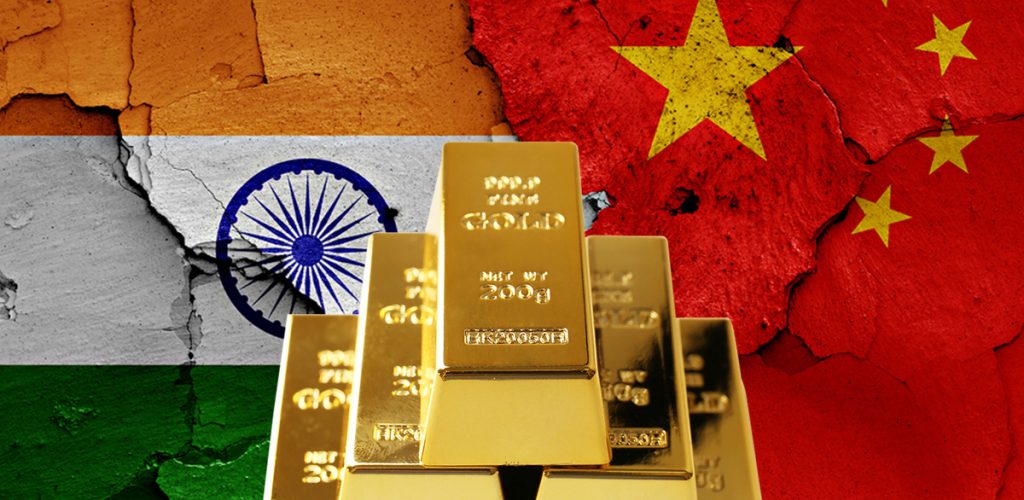 China has overtaken India as the world’s largest jewelry market, underscoring the country’s retail appetite for the yellow metal. A combination of economic uncertainty, cultural tradition, and social media frenzy has sparked renewed demand and attracted younger generations. In tandem with the government’s concerted effort to acquire gold, the nationwide hunger for gold is reshaping the global precious metals market.
China has overtaken India as the world’s largest jewelry market, underscoring the country’s retail appetite for the yellow metal. A combination of economic uncertainty, cultural tradition, and social media frenzy has sparked renewed demand and attracted younger generations. In tandem with the government’s concerted effort to acquire gold, the nationwide hunger for gold is reshaping the global precious metals market.
World’s Largest Gold Market
Shuibei, one of the largest retail gold markets in the world, mirrors China’s dynamic demand landscape and rich tradition of gold buying. Gold plays a central role in many Chinese customs with weddings, births, heirlooms, and Lunar New Year all involving the gifting of the yellow metal. Notably, younger generations are making up an increasing portion of the demand.
Retail buyers between 18 and 34 comprise more than one-third of jewelry consumption. Social media trends have helped add fuel to long-standing traditions. While younger buyers aren’t stacking gold bars, this physical demand has a direct influence on gold prices. For reference, the jewelry sector accounts for nearly half of global gold purchases.
Formidable Chinese Retail Gold Demand
In most countries, central bank gold demand drives total consumption. With the world’s second-largest population, China is an exception to this rule. The country’s behemoth gold market dwarfs government purchases, highlighting Chinese investors’ insatiable craving for gold. In 2022 and 2023, the jewelry market consumed 570.8 and 630.2 metric tons of gold, respectively. Despite falling slightly in 2024, gold jewelry still accounted for roughly 500 tons. In comparison, the People’s Bank of China (PBOC) gobbled up only 44 tons. That means the country’s jewelry gold demand is 10 times larger than the government’s purchases.
👉 Related Read: Who’s Driving Gold’s Remarkable Growth?
Central Bank Demand Still Robust
Jewelry demand might outpace annual central bank consumption, but the PBOC has been steadily ramping up its reserves. In 2024, China added 44 tons to its stockpiles, bringing total reserves to 2,280 tons, making it the eighth-largest gold holder in the world. The PBOC launched an 18-month gold-buying spree throughout 2023 and early 2024 but took a breather in mid-2024, pausing purchases for six consecutive months. However, after resuming acquisitions in November, China hasn’t looked back.
What’s driving Chinese demand?
Economic Instability
The Chinese economy faces a gauntlet of challenges, such as an inflated real estate market, low employment rates, and ongoing deflationary pressures. While purchases in other areas remain muted, demand for gold jewelry is robust, especially among younger generations. On a practical and traditional level, the yellow metal is sought out for its ability to store value and keep pace with inflation.
Dollar Weaponization
Despite being one of the US’ largest trading partners, China is a constant target of hefty sanctions. These economic pressures have ramped up since Russia invaded Ukraine, as the Kremlin and Xi Jinping have grown closer. This full-fledged weaponization of the dollar has spurred the PBOC to reduce its exposure to the dollar to minimize risk. Gold has been the go-to replacement for the world reserve currency.
Depreciating Yuan
The double whammy of domestic economic struggles and international isolation has weakened the Chinese yuan against the dollar, significantly eroding its purchasing power. This currency depreciation has fueled a surge in gold purchases at both the retail and national levels. Many Chinese investors are turning to physical, safe-haven assets like gold to protect their wealth. Meanwhile, the government is bolstering its economy to withstand the challenges ahead.
China’s Gold Binge to Continue
All signs point to China’s love affair with gold staying strong. Just last year, the country uncovered the world’s largest gold deposit, imposed gold-buying quotas, and doubled down on leading the global de-dollarization movement. With these clear intentions—coupled with worsening economic and geopolitical conditions—many experts predict Chinese demand will drive gold prices higher for the next decade.
A New Global Market Takes Shape
The United States may still hold the world’s largest gold reserves, but China has been accumulating at an unprecedented pace. Its strategy mirrors that of many emerging markets, driven by a dual motivation: domestic economic instability and concerns over the U.S. dollar’s potential weaponization. Together, these nations are reshaping global markets by diversifying away from the dollar, strengthening their gold reserves, and challenging the long-standing dominance of Western financial systems. As central banks across the developing world follow suit, the shift toward gold signals a broader realignment in global economic power.


